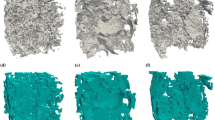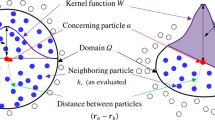Abstract
The presented model allows for fast simulations of the near-field behaviour of overflow dredging plumes. Overflow dredging plumes occur when dredging vessels employ a dropshaft release system to discharge the excess sea water, which is pumped into the trailing suction hopper dredger (TSHD) along with the dredged sediments. The fine sediment fraction in the loaded water-sediment mixture does not fully settle before it reaches the overflow shaft. By consequence, the released water contains a fine sediment fraction of time-varying concentration. The sediment grain size is in the range of clays, silt and fine sand; the sediment concentration varies roughly between 10 and 200 g/l in most cases, peaking at even higher value with short duration. In order to assess the environmental impact of the increased turbidity caused by this release, plume dispersion predictions are often carried out. These predictions are usually executed with a large-scale model covering a complete coastal zone, bay, or estuary. A source term of fine sediments is implemented in the hydrodynamic model to simulate the fine sediment dispersion. The large-scale model mesh resolution and governing equations, however, do not allow to simulate the near-field plume behaviour in the vicinity of the ship hull and propellers. Moreover, in the near-field, these plumes are under influence of buoyancy forces and air bubbles. The initial distribution of sediments is therefore unknown and has to be based on crude assumptions at present. The initial (vertical) distribution of the sediment source is indeed of great influence on the final far-field plume dispersion results. In order to study this near-field behaviour, a highly-detailed computationally fluid dynamics (CFD) model was developed. This model contains a realistic geometry of a dredging vessel, buoyancy effects, air bubbles and propeller action, and was validated earlier by comparing with field measurements. A CFD model requires significant simulation times, which is not available in all situations. For example, to allow correct representation of overflow plume dispersion in a real-time forecasting model, a fast assessment of the near-field behaviour is needed. For this reason, a semi-analytical parameter model has been developed that reproduces the near-field sediment dispersion obtained with the CFD model in a relatively accurate way. In this paper, this so-called grey-box model is presented.












Similar content being viewed by others
References
Decrop B, De Mulder T, Troch P, Toorman E, Sas M (2012). In: Coastlab 2012, Proceedings, pp 573–582
de Wit L, van Rhee C, Talmon A (2014) Env Fluid Mech:1–26
Decrop B, Sas M, De Mulder T, Toorman E (2014) In: International Conference on Hydroscience and Engineering, pp 737–744
Decrop B, De Mulder T, Toorman E, Sas M (2015) J Environ Eng 141(12):04015042
Saremi S, Jensen JH (2014) Coast Eng Proc 1(34). posters
Bray RN (2008) Environmental aspects of dredging. CRC Press
Breugem W, Bollen M, Sas M, Vandenbroeck J (2009). in CEDA Dredging Days 2009 - Dredging Tools for the Future Rotterdam
Spearman J, De Heer A, Aarninkhof S, Van Koningsveld M (2011). Terra et Aqua (125)
Decrop B, Sas M (2014) In: Particles in Europe 2014, pp 35–41
Newell R, Hitchcock D, Seiderer L (1999). Mar Pollut Bull 38(9):809
Hitchcock D, Bell S (2004) J Coast Res:101–114
Black KP, Parry GD (1999). Can J Fish Aquat Sci 56(12):2271
Smith S, Friedrichs C (2011). Cont Shelf Res 31(10):S50
van Rhee C (2002) On the sedimentation process in a trailing suction hopper dredger. Delft University of Technology. Ph.D. thesis
Jensen JH, Saremi S (2014) J Waterw Port Coast Ocean Eng 140(6)
Becker J, van Eekelen E, van Wiechen J, de Lange W, Damsma T, Smolders T, van Koningsveld M (2015) J Environ Manag 149:282
de Wit L, Talmon A, Van Rhee C (2014). Mar Pollut Bull 88(1):47
Decrop B, Mulder TD, Toorman E, Sas M (2015) Eur J Mech - B/Fluids 53(0):68
Decrop B (2015) Numerical and experimental modelling of near-field overflow plumes. Ghent University, KULeuven. Ph.D. thesis
Lee JH, Cheung V (1990). J Environ Eng 116(6):1085
Lee J, Chu V (2003) Turbulent jets and plumes: A Lagrangian approach. Springer
Lopez RJ (2001) Advanced engineering mathematics. Addison-Wesley. vol. 1158
Author information
Authors and Affiliations
Corresponding author
Additional information
Responsible Editor: Joris Vanlede
This article is part of the Topical Collection on the 13th International Conference on Cohesive Sediment Transport in Leuven, Belgium 7-11 September 2015
Rights and permissions
About this article
Cite this article
Decrop, B., De Mulder, T., Toorman, E. et al. A parameter model for dredge plume sediment source terms. Ocean Dynamics 67, 137–146 (2017). https://doi.org/10.1007/s10236-016-1017-0
Received:
Accepted:
Published:
Issue Date:
DOI: https://doi.org/10.1007/s10236-016-1017-0




